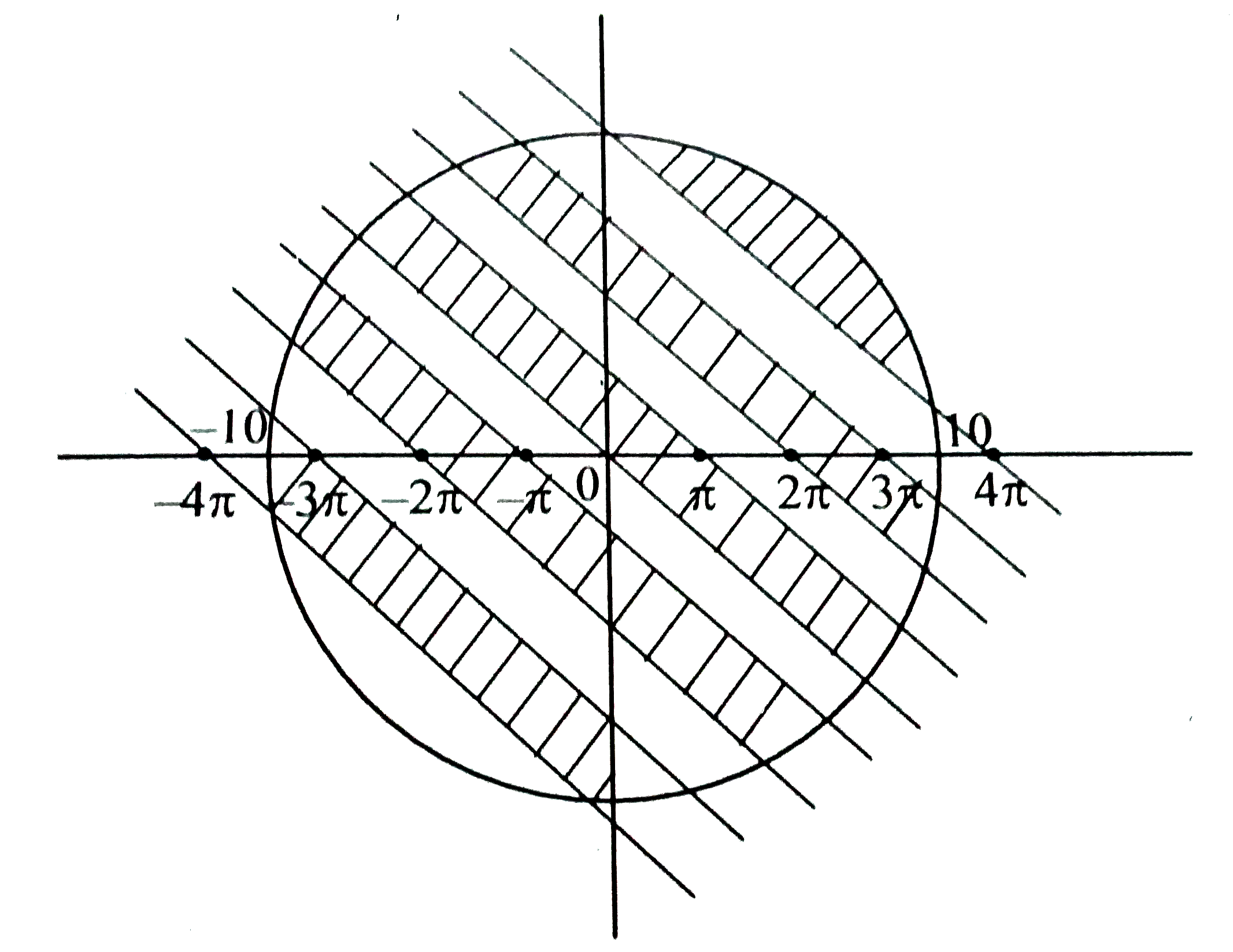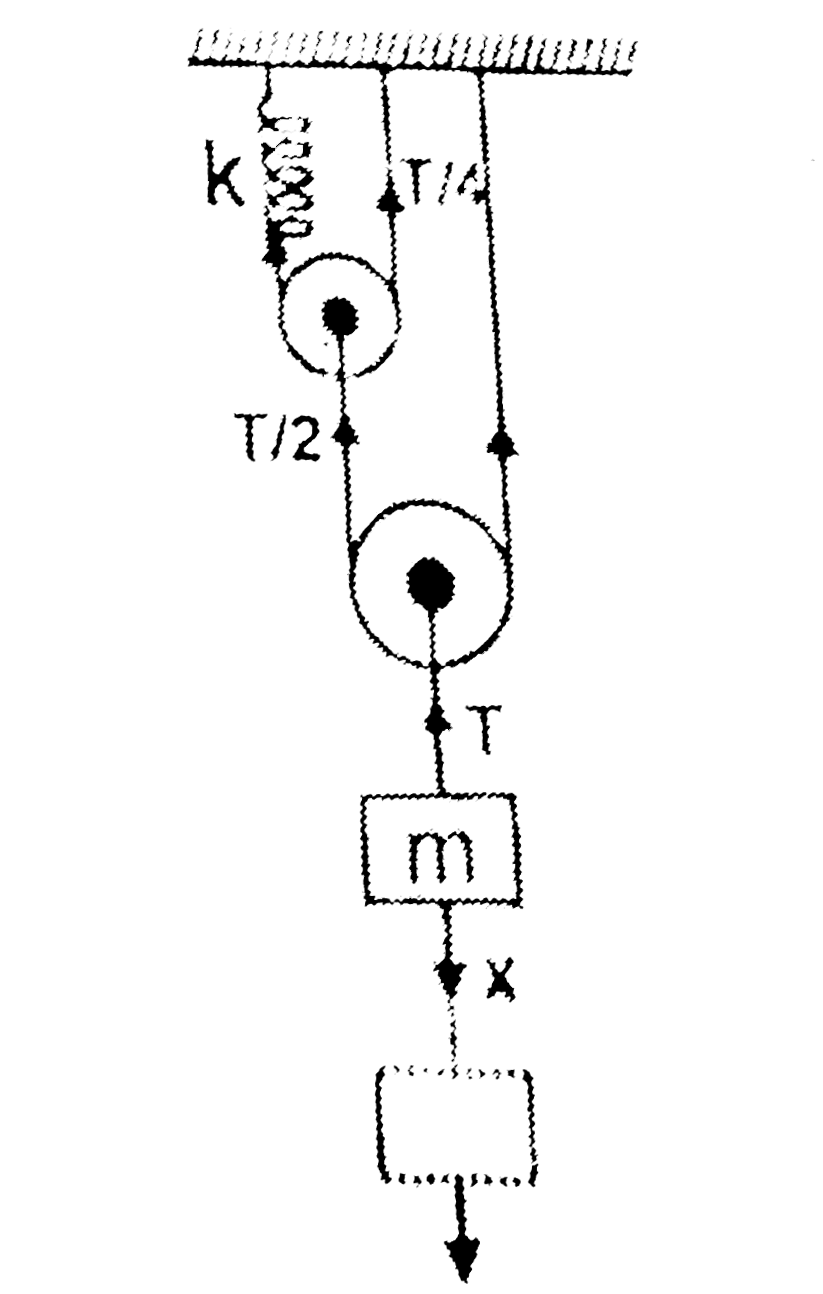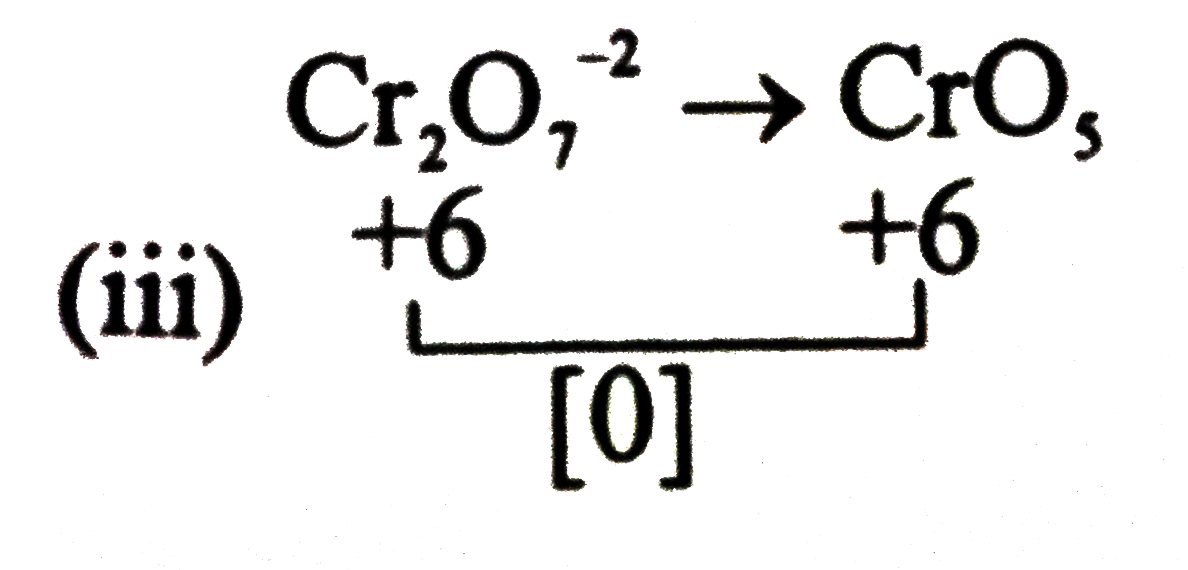InterviewSolution
This section includes InterviewSolutions, each offering curated multiple-choice questions to sharpen your knowledge and support exam preparation. Choose a topic below to get started.
| 2101. |
If a_(K)=(1)/(K(K+1)) for K=1, 2, 3....n, then (sum_(K=1)^(n)a_(K))^(2)= |
|
Answer» `(N)/(n+1)` |
|
| 2102. |
If y = tan ^(-1)((2x)/( 1+15x^(2)) ) , and (dy)/(dx)= ( lambda)/( 1+25x^(2))-( mu)/( 1+9x^(2))," then "lambda + muequal |
| Answer» ANSWER :A | |
| 2104. |
The sum of the series(12)/(2!)+(28)/(3!)+(50)/(4!)+(78)/(5!)+…is |
|
Answer» e |
|
| 2105. |
Consider the regions A = {(x,y)|x^(2)+y^(2) le 100} and = {(x,y) | sin (x+y) gt 0}in the plane. Then the area of the region Ann B is - |
|
Answer» `10 PI` `sin(x+y) gt 0` `x + y in (x,pi)uu (2pi,3pi)"……."` `x + y = c rarr "EQUATION of a line"`  REQUIRED area= shadedregion`= 1/2 pi(10)^(2) = 50 pi` |
|
| 2106. |
Using differentials, find the approzimate value of each of the following up to 3 places of decimal :(26)^((1)/(3)) |
|
Answer» |
|
| 2107. |
Sum to n terms of the series (1)/(1.4.7) + (1)/(4.7.10) + (1)/(710.13) +……. |
|
Answer» |
|
| 2108. |
Compute the are length of the ellipse (x^(2))/(a^(2)) + (y^(2))/(b^(2))=1 |
|
Answer» |
|
| 2109. |
{:("Column A","a and b are positive".(a + b):(b + 6) = 5 : 6,"Column B"),(b,,1):} |
|
Answer» If COLUMN A is LARGER |
|
| 2110. |
Consider the circle x^2 + y^2 + 8x + 10y- 8 = 0 (i) Find its radius of the circle x^2 + y^2 + 8x + 10y - 8 = 0 (ii) Find the equation of the circle with centre at C and passing through (1,2). |
|
Answer» |
|
| 2112. |
int_(0)^(pi//4) [sqrt(tan x) + sqrt(cot x)] dx is equal to |
|
Answer» `(PI)/(SQRT(2))` |
|
| 2113. |
Solve by matrix method: 4x+3y+2z=60, x+2y+3z=45, 6x+2y+3z=70 |
|
Answer» |
|
| 2114. |
Area of the triangle formed by the lines 3x^(2) - 4x y + y^(2) = 0 , 2x- y = 6is , |
|
Answer» 16 SQ unit |
|
| 2115. |
If the 7^(th) term of n A.P is 40. Then the sum of its first 13 terms is |
|
Answer» 520 |
|
| 2116. |
If A.M and G.M of x and y are in the ratio p:q, thenx:y is |
|
Answer» <P>a. `p - sqrt(p^(2) + Q^(2)) : p + sqrt(p^(2) + q^(2))` |
|
| 2117. |
Leta = - (x) /(1 + x^(2)) + (1)/(3) ((x)/(1 +x^(2)))^(3) + (1)/(5) ((x)/(1 + x^(2))^(5) + … andb = x (2)/(3) x^(3) + (1)/(5) x^(5) +(1)/(7) x^(7) - (2)/(9) x^(9) … then |
| Answer» ANSWER :2 | |
| 2119. |
A stone thrown at an angle theta to the horizontal reaches a maximum height h. The time of flight of the stone is:- |
|
Answer» `(SQRT(2H SIN THETA))/(G)` |
|
| 2120. |
Integrate the functions (x^(2)+x-1)/((x+1)^(2)(x+2)) |
| Answer» | |
| 2121. |
If x ^(3) + y ^(3) = 3axy then y _(2) = |
|
Answer» `(-2a ^(2) xy)/((y ^(2) -ax) ^(3)) ` |
|
| 2122. |
Express in the form a+ib:(3+5i)/(2-3i) |
|
Answer» SOLUTION :`(3+5i)/(2-3i)=((3+5i)(2+3i))/((2-3i)(2+3i))` `=(6+9i+10i+15i^2)/(9-9i^2)` `=(6-15+19i)/(4+9) =(-9)/(13)+(19i)/(13)` |
|
| 2123. |
The value of .^(n)C_(1)+.^(n+1)C_(2)+.^(n+2)C_(3)+"….."+.^(n+m-1)C_(m) is equal to |
|
Answer» `.^(m+n)C_(n) - 1` `= .^(n)C_(n-1)+.^(n+1)C_(n-1)+.^(n+2)C_(n-1)+"……"+.^(n+m-1)C_(n-1)` `=` Coefficient of `x^(n-1)` in `(1+x)^(n) [((1+x)^(m) -1)/((1+x) - 1)]` = Coefficient of `x^(n-1)` in `((1+x)^(m+n) -(1+x)^(n))/(x)` `=` Coefficientof `x^(n)` in `[(1+x)^(m+n) - (1+x)^(n)]` `= .^(m+n)C_(n) - 1` SIMILARLY, we can prove `.^(m)C_(1)+.^(m+1)C_(2)+.^(m+2)C_(3)+"...."+.^(m+n-1)C_(n)=.^(m+n)C_(m)-1` |
|
| 2124. |
If vertex and fous of a hyperbola are (2,3) and (6,3) respectively and eccentricity e of the hyperbola is 2, then equation of the hyperbola is : |
|
Answer» `((x+2)^2)/9-((y-3)^2)/27=1` |
|
| 2125. |
Let A(1/2,0),B(3/2,0),C(5/2,0) be the given points and P be point sashaying max (PA+PB,PB+PC)lt2. If area of region of point P is sqrt(3) ((pi)/a-(sqrt(3))/b) then a+b is |
|
Answer» |
|
| 2126. |
AB and CD are two equal and parallel chords of the ellipse (x ^(2))/(a ^(2)) + (y ^(2))/(b ^(2)) =1. Tangents to the ellipse at A and B intersect at P and at C and D at Q. The line PQ |
|
Answer» Passes through the ORIGIN |
|
| 2127. |
Classify 10^(-19)coulomb measures as scalar and vector. |
| Answer» SOLUTION :The GIVEN MEASURE is a SCALAR. | |
| 2128. |
Identify the correctoption |
|
Answer» `log_(2) 3 LT log_(1//4)5` |
|
| 2129. |
if y=sqrt((1-cos x )/(2)), the n prove that (dy)/(dx)=1/2cos" x/2. |
| Answer» | |
| 2130. |
Write down the set of letters forming that word Misrepresentation? |
|
Answer» <P> SOLUTION :{a,E,I,m,N,o,p,R,s,t} |
|
| 2131. |
Match List I with List II and select the correct answer using code gien below the lists: |
|
Answer» |
|
| 2132. |
Let G,O,E and L be positive real numbers such that log(G.L)+log(G.E)=3,log(E.L)+log(E.O)=4, log(O.G)+log(O.L)=5 (base of the log is 10) If the minimum value of 3G+2L+2O+E is 2^(lamda)3^mu5^nu ,Where lamda,mu,and nu are whole numbers, the value of sum(lamda^(mu)+mu^(nu)) is |
|
Answer» 7 |
|
| 2134. |
Consider the differential equation (dy)/(dx)=(y^(3))/(2(xy^(2)-x^(2))): Statement-1 : The substitutionz=y^(2) transforms the above equation into a first order homogeneous differential equation. Statement-2 : The solutionof this differential equation is y^(2)e^(-y^(2)//x)=C. |
|
Answer» A) Both STATEMENTS are false |
|
| 2135. |
Let G,O,E and L be positive real numbers such that log(G.L)+log(G.E)=3,log(E.L)+log(E.O)=4, log(O.G)+log(O.L)=5 (base of the log is 10) If the value of the product (GOEL) is lamda, the value of sqrt(loglamdasqrt(loglamdasqrt(loglamda....))) is |
|
Answer» 3 |
|
| 2136. |
The natural ............... |
Answer»  Thus the MAGNITUDE of T can be found as FOLLOWS : `implies T/4=K(4x)` `T=(16k)x` Thus equation of motion of mass m is `T= ma` `implies a=- (16 k)/m x` Comparing with `a=-omega^(2) x` we get `omega=sqrt((16 k)/m)` `implies f=omega/(2pi)=1/(2pi) sqrt((16 k)/m)` `=2/pi sqrt(k/m)` |
|
| 2137. |
(i)PbO_(2), H_(2)TiO_(4), BaO_(2), CrO_(5),H_(2)S_(2)O_(8),K_(3)CrO_(8) Total number of compounds having ge two peroxylinkages If both H_(2)O" and "D_(2)O are electrolysed then D_(2) Will be liberated at faster rate than, H_(2)(b) is (If statement is true, write b=1, If statement is false, write b=2) (iii) Cr_(2)O_(7)^(-2)+H^(+)+H_(2)O_(2)toCrO_(5)+H_(2)O In this reaction, the magnitude of change in oxidation number of chromium is ( c ) Answer is __________ [Express your answer as abc i.e. if a=1, b=2" and "c=3 is then answer is 0123] |
|
Answer» `{:("Compound""""Peroxy linkage"),(PbO_(2)""0),(H_(2)TiO_(4)""1),(BaO_(2)""1),(CrO_(5)""2),(H_(2)S_(2)O_(8)""1),(K_(3)CrO_(8)""4):}` (ii) `2` (iii) 
|
|
| 2138. |
Find the total number of lone pair in poly phosphoric acid having four phosphorous atoms. |
|
Answer» |
|
| 2140. |
If 0 lt a lt b, then int_(a)^(b) (|x|)/(x) dx= |
|
Answer» `a-B` |
|
| 2141. |
Mean of the binomial distribution is 100 then it standard deviation lies in ………… interval. |
|
Answer» `(0, 10)` |
|
| 2142. |
Evaluate |[2,4],[-5,-1]| |
| Answer» Solution :`|[2,4], [-5,-1]| = (2xx-1)-(-5xx4) = -2 + 20 = 18` | |
| 2143. |
Find the area enclosed by circle x^(2) + y^(2) = 4 ,parabola y = x^(2) + x + 1 , the curve y = [|sin^2 ""(x)/(4) + cos""(x)/(4)|] and x-axis |
| Answer» Solution :`((2PI)/(3) + SQRT3 - (1)/(6))` sq. UNIT | |
| 2144. |
In the line3x-y= kis a tangent to the hyperbola3x^(2) -y^(2) =3 ,then k = |
| Answer» Answer :D | |
| 2146. |
The probabilty of hitting a target is 1/3. The least number of times to fire so that the probability of hitting the larget atleast once is more than 90% is |
|
Answer» 4 |
|
| 2147. |
Smaller of (19^10 + 20^10) and 21^10 is |
|
Answer» `19^10 + 20^10` |
|
| 2148. |
At what values of a willthe curve y = x^(4) +ax^(3) + + 3/2 x^(2)+1 |
|
Answer» |
|
| 2149. |
If x,y,z are non-zero real numbers, then the inverse of A=[[x,0,0],[0,y,0],[0,0,z]] is |
|
Answer» `[[X^(-1),0,0],[0,y^(-1),0],[0,0,Z^(-1)]]` |
|
| 2150. |
If the argument of (z-a)(barz-b) is equal to that of ((sqrt(3)+i)(1+sqrt(3)i))/( 1+i) , where a,b are two real numbers and barz is the complex conjugate of the Argand diagram. Find the values of a and b so that be locus becomes a circle having its centreat (1)/(2)(3+i). |
|
Answer» `a=2 and b=1` |
|